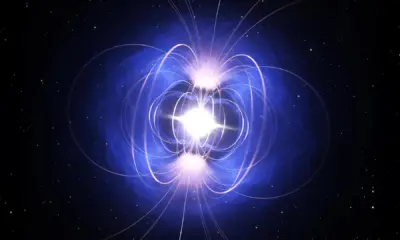Science
Astronomers Discover Unprecedented Celestial Object Named Punctum

Astronomers have identified a remarkable new celestial object located in the galaxy NGC 4945, approximately 12 million light-years from Earth. This compact radio beacon, nicknamed “Punctum,” emits a radio signal with a polarization level that defies existing classifications of cosmic entities. Researchers from the Instituto de Estudios Astrofísicos at the Universidad Diego Portales in Chile first detected Punctum using the Atacama Large Millimeter/submillimeter Array (ALMA).
While observing the bright core of NGC 4945, the team expected to find typical pulsar signals. Instead, they encountered a steady and highly polarized radio signal, which does not conform to any previously recognized categories of cosmic objects. Dr. Elena Shablovinskaia, the lead author of the study, described this discovery, stating, “None of these known types matches Punctum’s exact combination of properties.” The name Punctum, which means “point” in Latin, reflects its unique characteristics, standing out like a beacon amid the chaos of its galactic surroundings.
The polarization of light from Punctum is particularly striking, with levels reaching around 50% linear polarization at frequencies near 100 GHz. This is extraordinary, as light typically scatters chaotically in space. Polarization usually occurs only under specific conditions, such as when light passes through a uniform magnetic field. Dr. Shablovinskaia noted that the high polarization suggests a remarkably uniform magnetic environment, pointing to either a stable magnetic field or an unusual emission mechanism.
To understand the significance of such polarization, consider the behavior of ocean waves. Normally, waves scatter and twist under various forces. In contrast, Punctum’s light behaves like a continuous set of waves hitting the shore in perfect formation. This suggests that the magnetic fields guiding the light are exceptionally aligned, a rarity among cosmic sources. The fact that Punctum maintains a high polarization level indicates that it may either be a young pulsar with a stable beam or a magnetar, a type of neutron star with an extraordinarily strong magnetic field.
Despite ongoing observations with the NASA’s Chandra X-ray Observatory and the Australia Telescope Compact Array (ATCA), no X-ray or centimeter-wave counterparts have been detected, leaving Punctum effectively invisible at those wavelengths. Speculation about its nature includes the possibility of it being a young, energetic pulsar or a magnetar caught in an unusual state of emission. Dr. Shablovinskaia mentioned that the most plausible explanations are a young supernova remnant or a neutron star system such as a magnetar, both known for their strong magnetic fields.
Punctum’s unique characteristics make it a point of significant interest for astronomers. Its polarization could serve as a tool for mapping the invisible magnetic fields that permeate interstellar space. Dr. Shablovinskaia emphasized the importance of this discovery, stating, “Compact, highly polarized millimeter sources can exist in dusty, star-forming nuclei and be invisible at optical, X-ray, or radio wavelengths.” This suggests that uncovering similar objects could change our understanding of magnetic energy and its role in galaxy formation and evolution.
The implications of discovering more objects like Punctum are profound. They could lead to a new form of galactic cartography, revealing structures that are otherwise hidden from view through traditional optical telescopes. This potential depends on whether Punctum is a unique find or part of a larger population of similar celestial objects.
To further investigate, the research team is calling for coordinated multiwavelength follow-up observations. Dr. Shablovinskaia outlined the next steps, including high-resolution polarimetry with ALMA, very long baseline interferometry, and sensitive radio imaging, along with infrared searches using the James Webb Space Telescope. These observations will provide critical diagnostics to help determine whether Punctum is indeed a magnetar, a young supernova remnant, or something entirely new.
As astronomers continue to study Punctum, its unwavering signal stands as a bright question mark in the cosmos. This discovery not only represents a significant advancement in our understanding of the universe but also highlights the potential for uncovering new knowledge about the magnetic forces that shape galaxies. The team’s findings are available as a preprint on arXiv and are set for publication in the journal Astronomy & Astrophysics.
-

 Technology5 months ago
Technology5 months agoDiscover the Top 10 Calorie Counting Apps of 2025
-

 Technology2 weeks ago
Technology2 weeks agoOpenAI to Implement Age Verification for ChatGPT by December 2025
-

 Health3 months ago
Health3 months agoBella Hadid Shares Health Update After Treatment for Lyme Disease
-

 Health3 months ago
Health3 months agoErin Bates Shares Recovery Update Following Sepsis Complications
-

 Health3 months ago
Health3 months agoAnalysts Project Stronger Growth for Apple’s iPhone 17 Lineup
-

 Technology5 months ago
Technology5 months agoDiscover How to Reverse Image Search Using ChatGPT Effortlessly
-

 Technology3 months ago
Technology3 months agoElectric Moto Influencer Surronster Arrested in Tijuana
-

 Technology2 months ago
Technology2 months agoDiscover 2025’s Top GPUs for Exceptional 4K Gaming Performance
-

 Technology5 months ago
Technology5 months agoMeta Initiates $60B AI Data Center Expansion, Starting in Ohio
-

 Technology5 months ago
Technology5 months agoRecovering a Suspended TikTok Account: A Step-by-Step Guide
-

 Health5 months ago
Health5 months agoTested: Rab Firewall Mountain Jacket Survives Harsh Conditions
-

 Lifestyle5 months ago
Lifestyle5 months agoBelton Family Reunites After Daughter Survives Hill Country Floods





















